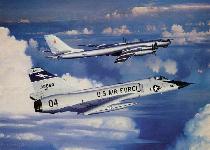
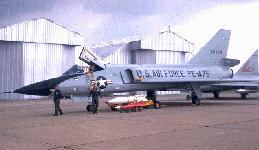
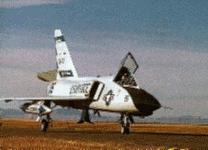
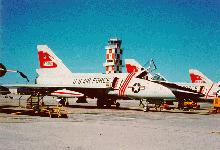
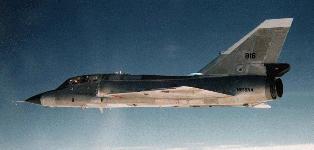

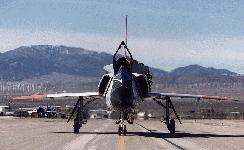
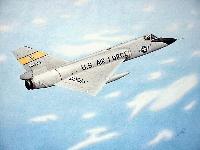






The F-106 began development as an improved version of the F-102 Delta Dagger all-weather interceptor. Originally known as the F-102B, extensive structural and system changes resulted in the aircraft being redesignated as an F-106. . The delta wing remained substantially unchanged, but the fuselage was modified to accommodate more powerful Pratt & Whitney J-75 turbojet. Engine intakes were re-located behind the cockpit and were variable for optimum engine performance at all speeds. The cockpit was moved forward relatively, and the shape of the fin and rudder changed. A new undercarriage was fitted, with steerable twin nose wheels. First flight was December 26, 1956, and delivery began to Air Defense Command units in July 1959. The F-106 attained initial operational capability with ADC in October 1959. The F-106 remained the mainstay of the U. S.'s air defense until 1988 when the last Delta Darts were withdrawn from service.
The F-106 was fitted with the sophisticated Hughes MA-1 electronic and fire control system and worked in conjunction with the SAGE (Semi-Automatic Ground Environment) defense system. The MA-1 took over control of the plane shortly after takeoff and guided it to the proper altitude and attack position. The system would then lock on and fire the F-106 weapons at the intruder aircraft, and return the plane to the vicinity of its air base, where the pilot took over control for landing.
Specifications | |
| Wing Span | 38 feet, 3.5 inches |
| Length | 70 feet, 8.75 inches |
| Height | 20 feet, 3.5 inches |
| Weight | 35,000 lbs. maximum |
| Armament | One Douglas AIR-2A Genie rocket with nuclear warhead, plus four AIM-4 Falcon missiles |
| Engine | One Pratt & Whitney J75-P-17 engine with 24,500 lbs. of thrust, with afterburner |
| Cost | $3,310,000 |
| Maximum speed | 1,525 mph |
| Cruising speed | 650 mph |
| Range | 1,500 miles |
| Service Ceiling | 53,000 feet |









